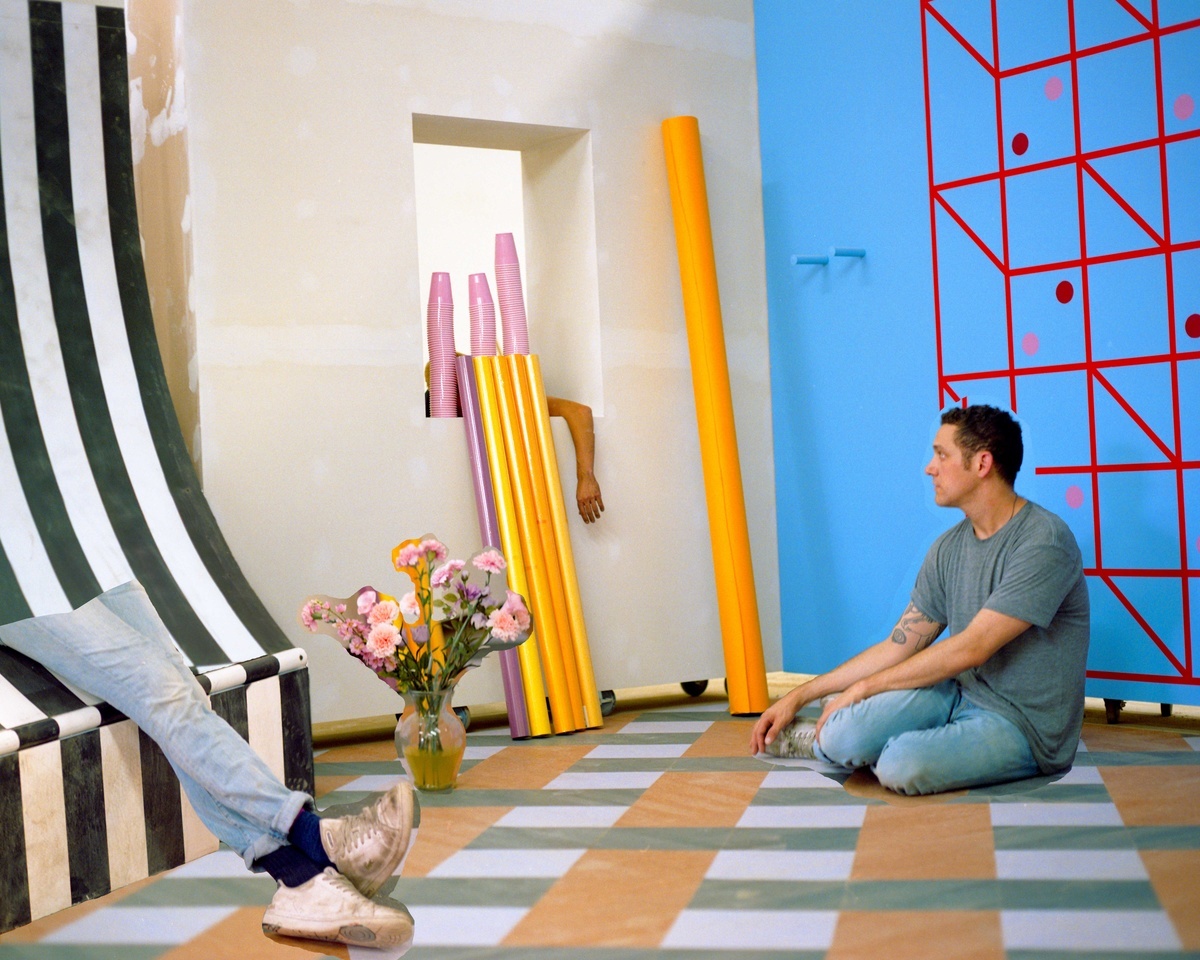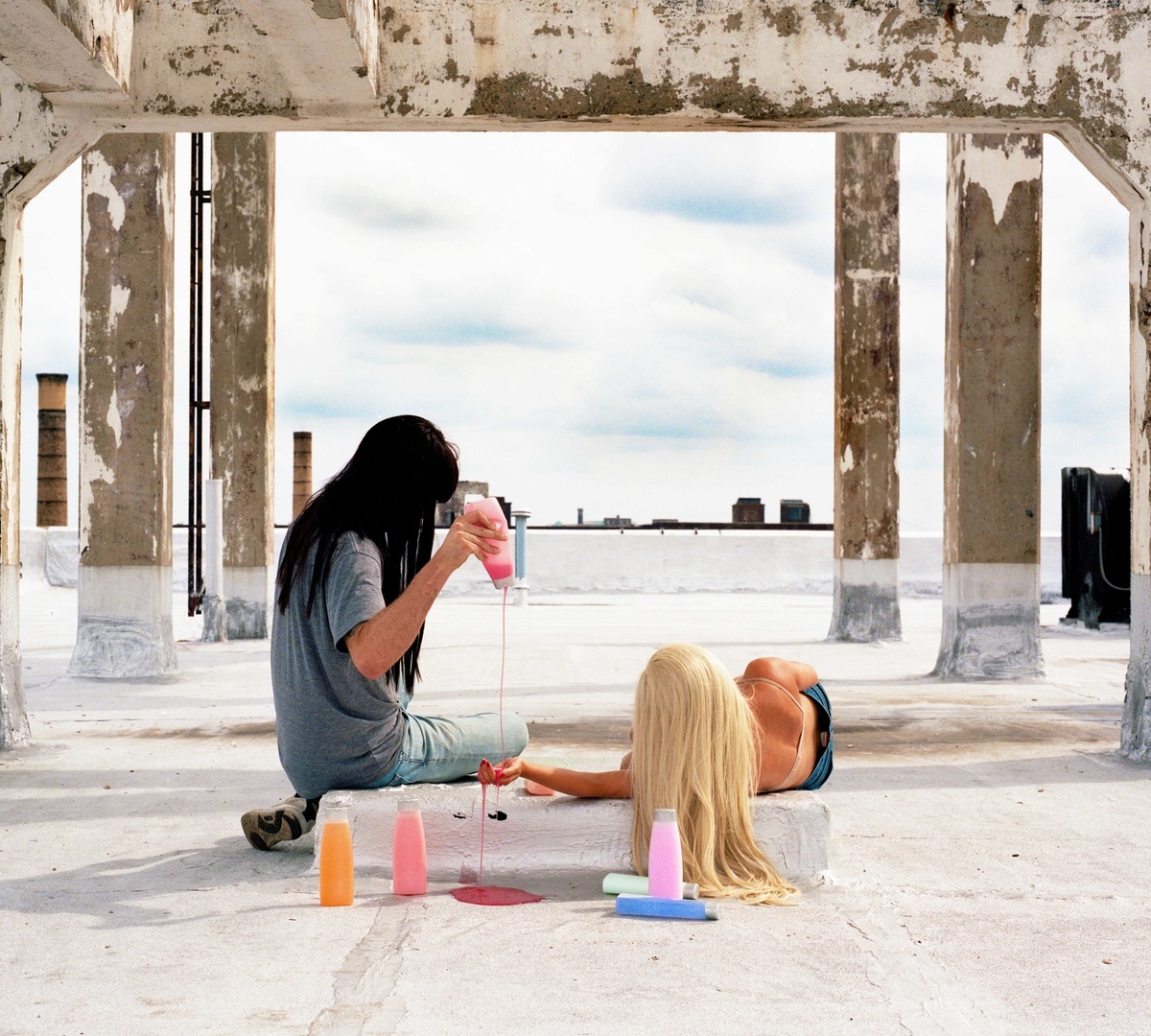Philadelphia’s Nicetown neighborhood couldn’t be a more aptly named location for artist Alex Da Corte’s studio, a pastel and neon oasis of sugar and plastic with Grimes or Crowded House blaring from every corner. The massive former sweet factory filled with artists’ workspaces radiates energy in the industrial landscape. Even standard studio supplies are sunnier here. Rainbows of bottles of shampoo, soda, and detergent, all arranged by color, labels removed, are lined up neatly along the walls in Alex’s studio. Wardrobe options for characters in his films, often played by himself or an assistant, span another wall, and include a parade of wigs, a silver fireman’s suit, and a vanity of prosthetics. After a quick succession of prestigious gallery shows over the past year (Joe Sheftel, White Cube), Da Corte is in full swing preparing for “Easternsports,” his September exhibition of video works with Jayson Musson at the Institute of Contemporary Art in Philadelphia.
Da Corte’s intricately built, geometrically patterned film sets and delicate framed works composed of found materials like paper and silk ribbon, only reveal their full dimensions when viewed in person. Handing me a labelless fluorescent orange energy drink, Alex gives me a tour of the expansive warehouse, from carnivalesque studios to a metallic industrial garage to a sprawling rooftop, with its view of abandoned, rusting water tank towers.

You often incorporate other artists’ work into your art, such as Fun Sponge (2013), which included artworks by Andrew Gbur, Sascha Braunig, Nancy Lupo, and several others. Do you consider these collaborations?
I think of these works as collaborations in the same way that I collaborate with V05 when using their shampoos [White Rain, 2014]. At its best, the relationship is mutualistic and all parties experience something by the reinvention of their work that raises questions and takes their ideas into a different state or realm of the world. When working with the artists (if they are living), we discuss the work and the ideas about it, and then, like many of the store-bought or found objects I use. it is folded into a hybrid form, or has a new stage created for it. The work cohabits with the new material for a time, and then, like all things, the relationship comes to an end and they part ways. In that time, a change has occurred.
You take a lot of liberty in shaping visual identities, whether by wearing costumes or creating those of the (real or imagined) figures in your installations.
Yes – I think of this platform as one that is ripe for invention. The work and the world I am cultivating is not new, or even strange, but it is isolated and analysed and reconfigured, amalgamations with brutal junctures that cross, flatten, and upend disparate histories, classes, politics, and tastes. The characters and myths that grow from these remixes are archetypes as well, repositioned within this hybrid system and then left to see if the myth still lives out of context, and what it will cultivate.

It seems like your background in animation has inspired your earlier, flattened works (such as the framed collages in Fun Sponge, and portraits of Halle Berry and other celebrities), yet your recent work is composed of three-dimensional, room-sized installations. Does animation inform these newer installations?
The installations are meant to be experienced in the round, but I create them in such a way so they unfold to the viewer as a film might, scene after flat scene. By layering and dividing colors, images, and texture into rooms or zones, time becomes a major factor in discovering the work. The scent of the room might strike you before the warmth of the lights, and then the violence of the red walls or the hysteria of the patterned tiles, before you ever encounter the backside of the object in the room. In animation, there is much talk of anticipation. How does one create anticipation frame by frame, and still image after still image? In order to see the movement, there needs to be a frame inserted that anticipates the action so that the eye can see it. I use this kind of logic to precipitate the viewers’ experiences as they pass through the installations.
In making these arrangements of common commercial products (Pine Sol, Doritos, VO5 shampoo), is there anything you find irresistible? What’s your vice in the supermarket?
I like thinking about scale and volume when it comes to stacking. In movie theaters or supermarkets, the presence of a cheap cardboard stage creates a dynamic vehicle where small, unsubstantial M&Ms or 3D glasses can live. To think that the sale of a small blue M&M can change based on the presence of a large cardboard structure seems comical, but these special effects are powerful and shape our communities and our taste. Anytime I see a large volume of stuff, I fall in love and I buy it because the special effects are working, and I like that they are.
Credits
Text Jennifer Piejko
Photography Job Piston
